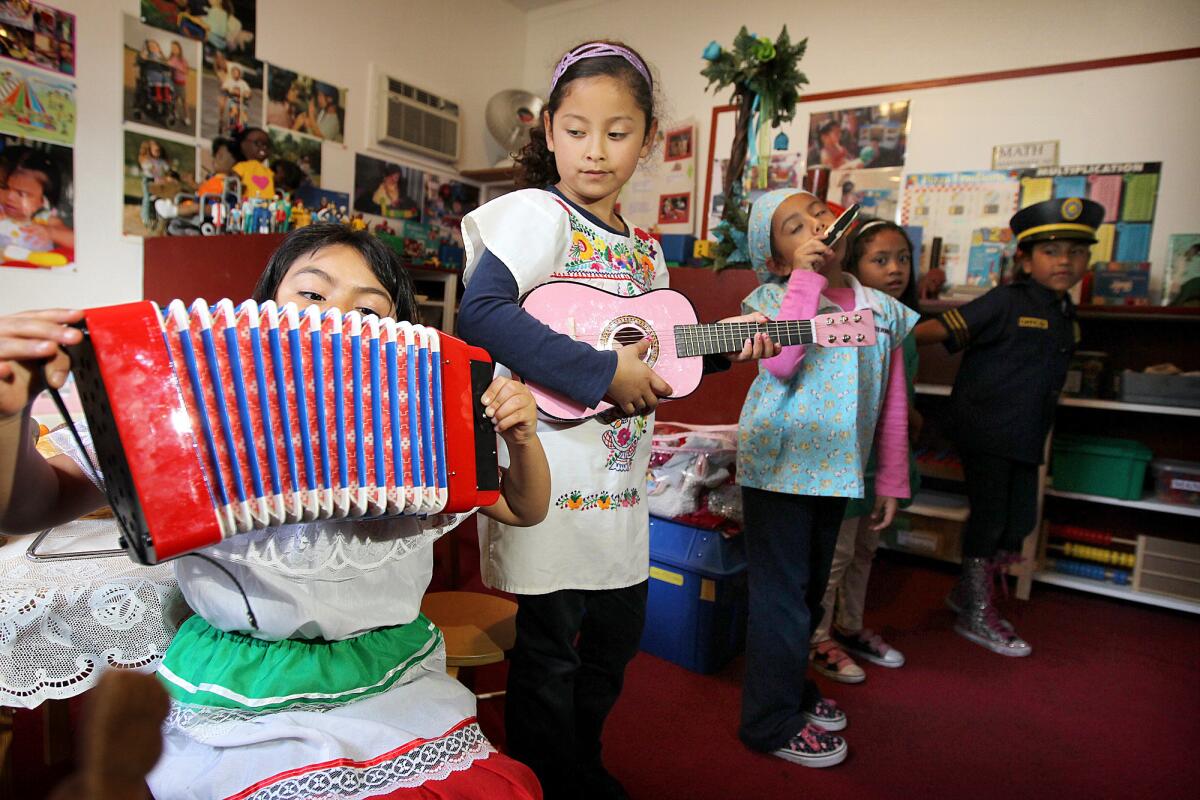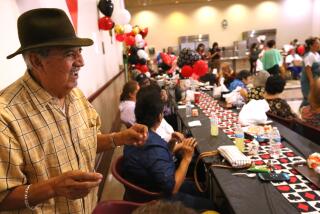The 2010 census missed thousands of California’s Latino children. Here’s what could change in 2020

Children play at Ramona’s Day Care in Long Beach. More than 113,000 young Latinos in California weren’t counted in the 2010 census, a new study says, with 47,000 of them in Los Angeles County.
Reporting from Washington — More than 113,000 young Latinos in California weren’t counted in the 2010 census, a new study says, and Latino advocacy groups want to be sure the U.S. Census Bureau is working to reduce that number in 2020.
With an estimated 47,000 uncounted Latino children, Los Angeles County alone is home to 12% of the estimated 400,000 Latino children in the U.S. not counted in 2010, according to a study released Tuesday by the National Assn. of Latino Elected and Appointed Officials Educational Fund and Child Trends’ Hispanic Institute.
With preparations already underway for the 2020 Census, the groups hope their study will spur Congress and the U.S. Census Bureau to look at how to better count the Latino population.
“It’s not a very sexy topic, it’s not one that we talk about very often… but the fact is that our democratic system is based on the decennial census,” NALEO Educational Fund Executive Director Arturo Vargas said. “Whenever anybody is not counted in the census, our democracy is less perfect, and our form of government is less perfect and our policy-making is less perfect.”
Vargas, who lives in Los Angeles’ Mount Washington neighborhood, takes it personally.
“Any undercount in Southern California is bad for Southern California. It results in less money flowing into the region,” he said.
There is a chance California could gain another congressional seat in 2020, and “that will depend on every one being counted,” Vargas said. “It masks what the real population looks like in Los Angeles County when you are missing 47,000 children.”
In a statement, the Census Bureau said it is studying ways to reach groups that are historically undercounted.
The data collected by the U.S. Census each decade is used to draw congressional districts. The number of residents on a particular street can determine how the U.S. divvies up more than $400 billion in annual federal spending, including money for programs such as Head Start or the Special Supplemental Insurance Program for Women, Infants and Children that directly benefit young children.
Child Trends’ Hispanic Institute Director Lina Guzman said making sure young Latinos have equitable access to government services will matter more as the Latino population in the U.S. continues to swell. One in 4 American children is Latino, and that proportion is expected to expand to 1 in 3 by 2050.
Whenever anybody is not counted in the census, our democracy is less perfect.
— Arturo Vargas, NALEO Educational Fund executive director
“How Latino children fare will have profound implications for our country’s future well-being,” she said. “An undercount of young Latino children is costing states money for those children most in need.”
The study was released during a Capitol Hill briefing Tuesday morning. Author William O’Hare, a social and health psychology researcher who used to work for the Census Bureau, compared birth, death and immigration records in each county to the county level results of the 2010 census.
He and the study’s other authors found that the Census Bureau should have identified more than 21 million Americans 4 or younger in 2010, but only counted about 20 million. Of those missing million people, about 40% were Latino, he said.
About three-fourths of the uncounted children live in California, Texas, Florida, Arizona or New York, according to the study.
Along with Los Angeles County, several other California counties made the list of 25 counties with the highest number of uncounted Latino children. San Diego County has an estimated 12,000 uncounted children; Orange County has 15,000; Riverside County has 6,000; San Bernardino, Santa Clara and Alameda Counties each have 3,000; and Sacramento County has an estimated 1,000 uncounted children, according to the report.
“This undercount of young Latino children across the country is highly concentrated in a relatively small number of states,” O’Hare said. “We know with a great deal of confidence exactly where it’s happening.”
O’Hare said the undercount is likely caused by the high number of Latino families living in rentals, in high poverty areas or in complex living arrangements where a child might not live with a legal guardian — all situations that traditionally make it harder for the census to count people.
But he said the Census Bureau needs to do more research to understand why the children aren’t being counted. He said some adults may not understand that children should be included in the census answers or are afraid to respond over fears of how it might affect their own legal status, even if the child is a legal resident.
“We really don’t collectively have a lot of good evidence about why young Latino children are missed,” he said.
Since the late 1990s, the U.S. Census Bureau has used a similar methodology to study how and why the census undercounts young children in general. The most recent report, presented to the Bureau on April 12, found similar figures for the number of undercounted Latino children. The report also contained similar reasoning why the youngsters are missed, including a hypothesis that adults are less likely to record a child staying with them if he or she is a grandchild, relative or acquaintance rather than direct descendant.
“Some groups have historically been undercounted for a variety of reasons and the Census Bureau takes this undercount seriously,” the statement from the bureau said. “We have several active research groups to shed light on the characteristics of these missed young children and their households and how to count them more accurately.”
The April 12 report recommended focusing advertising on young mothers and grandparents, and working with local advocacy groups to get the word out.
The Census Bureau has been preparing for years for the 2020 test — which will play out for the first time online and through phone surveys — designed to count the estimated 330 million people in the U.S. It is currently testing a new data-collection application in the Los Angeles area in English and Spanish, among other languages.
The Census Bureau hasn’t focused specifically on counting young Latinos as much as it has young people in general. Vargas, who serves on the bureau’s National Advisory Committee on Racial, Ethnic and Other Populations, said that needs to change.
Vargas said with less than two years before census questions, procedures and methodology are determined for 2020, NALEO and other advocacy groups want to be sure the Census Bureau is actively considering how to reach out to areas with the highest number of uncounted Latinos.
See more of our top stories on Facebook >>
They recommended talking with families through schools, pediatricians and government programs such as Head Start; asking advocacy groups to work in communities; and targeting advertising in counties known to have high numbers of children not counted in the past.
NALEO will do its part as well by reaching out to Southern California Latinos ahead of the 2020 census and blanketing Spanish language media with the reminder that everyone needs to be counted, Vargas said. In hopes that children will remind their parents to fill out the census form, NALEO will work with Los Angeles Unified School District and others to use the bureau’s curriculum to teach students why the census matters.
“What we are doing here today is sounding the alarm,” Vargas said. “Time is running out.”
Follow @sarahdwire on Twitter
Read more about the 55 members of California’s delegation at latimes.com/politics
ALSO
Obama administration starting in L.A. to help immigrants become citizens
Supreme Court rejects voting-district challenge that would have weakened Los Angeles’ clout
Asians to surpass Latinos as largest immigrant group in U.S., study finds
More to Read
Get the L.A. Times Politics newsletter
Deeply reported insights into legislation, politics and policy from Sacramento, Washington and beyond. In your inbox three times per week.
You may occasionally receive promotional content from the Los Angeles Times.











